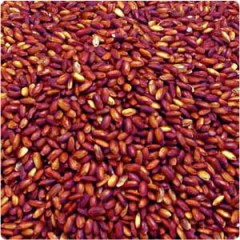RED RICE FOR THE METABOLISM OF CHOLESTEROL
Products made from red rice
Products for the cardiovascular system

Red rice is obtained by the fermentation of common rice (Oryza sativa) with Monascus purpureus , a yeast pigments which give the rice grains the typical red color . During fermentation, this fungus produces numerous substances, monacolins , of which the most important of monacolin K. The chemical structure and the pharmacological action of monacolin K are identical to those of lovastatin , known molecule used for its cholesterol-lowering activity . Indeed the monacolin K , such as lovastatin , inhibits the activity of the enzyme HMG -CoA reductase and consequently the synthesis of cholesterol in the body .
Reduction in cardiovascular events and dyslipidemia
In a recent double-blind study versus placebo was compared to the administration of 10 mg of monacolin in 25 subjects with hypercholesterolemia light for 4 weeks. Participants who had taken monacolin have shown favorable results in terms of total cholesterol (-12%) , LDL cholesterol ( -21.99 %) , non- LDL cholesterol (total cholesterol - HDL cholesterol ) ( -14.67 %) , matrix metalloprotease 9 ( -27.19 % ) and C-reactive protein in high sensitivity ( hs- CRP ) ( -23.77 % ) . In a review of 22 studies , a total of 6520 participants, the red rice has shown significant benefits in all causes of death , and death from coronary heart disease, myocardial infarction and revascularization compared to placebo. Major reductions have been reported in total cholesterol, triglycerides , LDL cholesterol , with the increase of the HDL . In a double-blind study ( Verhoeven et al. , 2013 ), 52 doctors and their spouses with cholesterol greater than 200 mg / dL have taken 5 mg 2 times / day of monacolin K for 8 weeks , after which LDL cholesterol decreased by 22 % and 15% of the total . Lu et al. (2008 ) analyzed data from a prospective, randomized double-blind study of 4.5 years , to test the effects of red rice (300 mg / day) in reducing cardiovascular events in 5,000 subjects in the post- myocardial infarction by at least 60 months. The levels of total cholesterol are declined by 13% from baseline and those LDL by 20%. The reduction in total cardiovascular events (myocardial infarction or cardiac death in general) has been impressive : 45% of major coronary events , 62 % in the incidence of non-fatal myocardial infarction and 32% in fatal coronary events . Lin et al. (2005) evaluated the lipid-lowering effect and safety of red rice in a randomized double-blind placebo control in 79 pcs 23 - 65s with hyperlipidemia. Participants received 600 mg 2 times / day or a placebo for 8 weeks. At the end of the study treatment with red rice reduced LDL cholesterol by 27.7 % , total cholesterol by 21%, triglycerides by 15.8 % and apolipoprotein B by 26%. Gheith and colleagues compared the efficacy and safety of administration of red rice in a study of 72 pcs . with nephrotic dyslipidemia . Divided into 3 groups of 20 participants have taken red rice (600 mg 2 times / day ), 30 fluvastatin (20 mg / day) and 22 no therapy . The average levels of total cholesterol in the fluvastatin group were respectively 436 , 333, 313 and 302 mg / dL at baseline to 3 months, 6 months and 1 year . Similar reductions were observed in the group of red rice : 457 mg / dL base, 408 at 3 months, 283 at 6 months and 303 after 1 year. In both groups was observed the decrease in proteinuria ( fluvastatin 8.3 g / day of v baseline . 2.4 g / day to 1 year red rice 8.6 g / day of v baseline . 3.2 g / day to 1 year ), but not in the control group.
Intolerance to statins
In their review of studies of 1,400 pcs , Venero et al. have identified 25 subjects intolerant to statins , to whom they have given 1200 mg / day of red rice at bedtime for 4 weeks or more . Total and LDL cholesterol decreased by 37 and 35 mg / dL in an average period of 74 days. 15 of the 17 patients have tolerated the red rice . Halbert et al. have given 2,400 mg 2 times / day of red rice or pravastatin 20 mg for 12 weeks in 43 patients with statino - related myalgia . There were no significant differences in total cholesterol , LDL, HDL or triglycerides. 1 of 21 units that had taken red rice and 2 of 22 of pravastatin have stopped therapy for myalgia. Even Becher et al. (2009) suggest that the red rice (1800 mg 2 times / day) may be a viable option for the treatment of hyperlipidaemia in pc who can not tolerate statins.
Useful in case of
• HYPERCHOLESTEROLEMIA
• INTOLERANCE TO STATINS
• HYPERTRIGLYCERIDEMIA
• CARDIOVASCULAR PROTECTION
REFERENCES :
• Cicero AF , Derosa G , Parini A, Maffioli P , D'Addato S , Reggi A, Giovannini M , Borghi C. Red yeast rice improves lipid pattern, highsensitivity C - reactive protein , and vascular remodeling parameters in moderately hypercholesterolemic subjects English . Nutr Res 2013 Aug ; 33 (8) :622-8 .• Ong HT , Cheah JS . Statin alternatives or just placebo : an objective review of omega -3 , red yeast rice and garlic in cardiovascular therapeutics . Chin Med J ( Engl ) . 2008 Aug 20; 121 (16) :1588-94 . # 0374 3% Monacolin K with Coenzyme Q10 Red Rice
Products made from red rice
Products for the cardiovascular system
